Crafting the best Amazon PPC strategy is essential, not just throwing products on Amazon and hoping for sales. To achieve optimal results and see real ROI, it’s crucial to develop a targeted approach. A well-structured amazon ppc campaign strategy ensures that your efforts are focused and effective.
At its core, Amazon PPC involves paid ads to drive traffic to your listings and increase conversions. With the right approach, you can target the right audience, drive high-quality traffic to your listings, and see a significant ROI on your ad spend.
If you’re looking for the best Amazon PPC strategy guide out there, you’ve come to the right place. At FosterFBA we live and breathe advertising and are proud to be an Amazon Advertising Verified Partner. To get started with Amazon PPC, it’s important to have a basic understanding of all the terminology, how different targeting methods work, and more. Here, we’ll not only teach you what works well but also what mistakes to avoid. After all, learning from others’ mistakes is often the best way to make sure your own campaigns are a success.

So if you’re ready to get started with your Amazon PPC strategy, keep reading! With the help of this comprehensive Amazon PPC strategy guide (Part A) and 10 Advanced Ad Strategies (Part B), you’ll be well on your way to achieving Amazon success in no time.
Key Takeaways
- Understanding Amazon PPC basics is crucial for success in driving traffic and increasing conversions.
- Developing a targeted approach, understanding terminology, campaign types, and bidding strategies are essential for a successful Amazon PPC strategy.
- Amazon PPC can help improve product visibility, organic ranking, and overall revenue, making it worth the investment for many sellers.
- Optimizing your Amazon listings before running PPC ads can improve ad conversion rates.
- Different types of Amazon PPC ads include Sponsored Products Ads, Sponsored Brand Ads, Amazon Display Ads, and Amazon Video Ads.
Part A: Basic Amazon PPC Strategy Guide
As an Amazon seller, you probably know that an effective Amazon PPC strategy is a critical part of your marketing mix. But do you know how to make the most of it? In this section, we’ll teach you the basics of Amazon PPC to get you started.
We’ll make sure you have a good understanding of terminology, campaign types, and bidding strategies. Then you can jump into the next section with more advanced Amazon PPC strategies and some of our favorite Amazon PPC hacks to help you find even more success from your paid search campaigns.
What is Amazon Pay-Per-Click (PPC)?
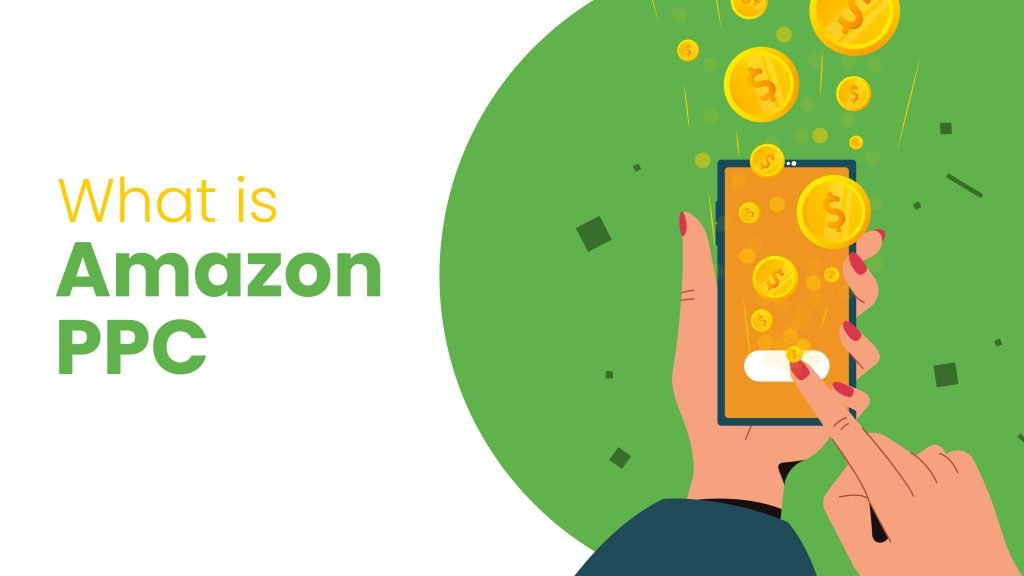
Amazon PPC (also called Sponsored Ads) is a form of online advertising that allows merchants to bid on certain keywords and place their ads at the top of search, product pages or rest of search placements for those keywords. With Amazon PPC advertising, you can get more eyes on your products which will help increase sales, but it can also help your product rank organically, which can increase long-term sales as well. An effective amazon ppc campaign strategy is crucial for leveraging these benefits and ensuring sustained growth.
One of the greatest benefits of Amazon PPC is that you only pay when someone clicks your ad. It’s not like some PPC models where you pay for impressions that don’t lead to clicks.
How does Amazon PPC auction work?
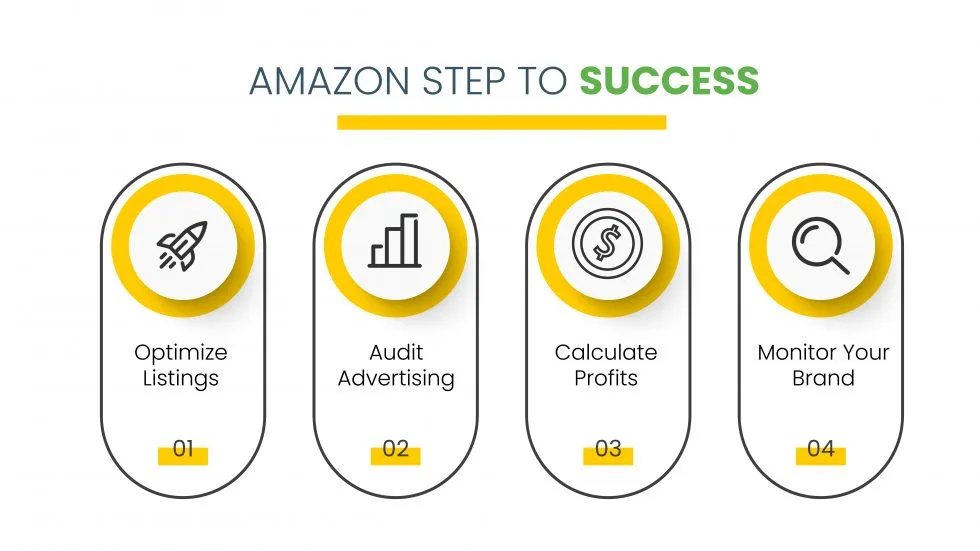
If you’ve never run a PPC campaign on Amazon before, it may seem a bit confusing at first glance. Luckily, it’s actually quite simple! With Amazon PPC, advertisers (that’s you) submit a default bid which puts them in competition against other advertisers for sponsored ad spots for certain keywords or on certain pages.
The advertiser with the highest bid for that particular keyword will win, and their ad will appear at the top of the search results or in one of the other ad placements.
However, it’s important to remember that your bid may not be the amount you pay. It’s just the amount you’re willing to pay up to. You only pay $0.01 above the bidder below you.
Let’s look at an example: if you bid $1.25 for a keyword and your competitor only bids $1.00, you will win the ad spot at $1.01. This is important to remember because just because you’re bidding a certain amount doesn’t mean you’re necessarily going to pay that amount. It all depends on the second-highest bid, and if theirs is significantly lower than yours, you can win the sponsored ad spot for much less than you bid.
Basic PPC Terminology on Amazon
Along with understanding how the PPC auction works, it’s also important to be familiar with some basic terminology so that you understand the different types of bidding, campaign types, and more that you’ll come across while creating your campaigns.
It’s can be a lot of new words to wrap your head around if you’re new to PPC on Amazon, so we’ve provided a quick review of the most important terms to understand:
Dynamic bidding: This is a type of bidding strategy where Amazon will automatically adjust your bid when it sees performance changes. If you select “down only,” Amazon can lower your bid by up to 100%, and if you select “up and down,” Amazon can lower or increase your bid by up to 100%.
Search terms: This refers to the search query the user types into the search bar on Amazon when they’re looking for a product.
Keywords: This refers to the word or phrase you’re bidding on for your ad campaigns.
Negative keywords: These are words or phrases you want to exclude from your campaign to prevent your ads from showing up when they’re included in a search with your keywords. For example, if you’re selling selling “suits,” you may want to add “swim” as a negative keyword, so your products aren’t showing up with someone searching for “swim suits.”
Conversion rate: the Amazon PPC conversion rate is calculated by the number of conversions divided by the number of clicks. (Example: 20 conversions/100 clicks would be a 20% conversion rate.)
ACOS (average cost of sales): Amazon PPC ACOS compares the amount spent on PPC campaigns to the amount earned, so you know if your ads are cost efficient. It’s calculated by dividing ad spend by ad revenue and converting it to a percentage. (Example: $100 spent on ads and $200 earned from it would make your ACOS 50%)
Campaign types: There are two types of Amazon PPC campaigns: automatic and manual.
- Automatic campaigns are more beginner-friendly because Amazon runs your ads for you. Amazon’s algorithm will choose keywords and placement types related to your product listing.
- Manual campaigns allow you to have control over your keywords which can lead to more accurate results if you know what you’re doing.
Keyword match types: Amazon PPC campaigns have different keyword match types, which help determine how closely related a search term needs to be for your ad to be displayed. These include:
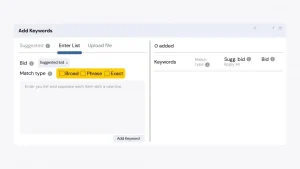
- Broad match: Your ad will be displayed for any search term that contains your keyword, regardless of order. It may also show up for similar terms.
- Phrase match: Your ad will only appear if a search query contains your keyword in the exact order along with words before or after the phrase.
- Exact match: Your ad will only appear if a search term exactly matches your keyword without any additional words or phrases.
Is Amazon PPC worth it and how much should I spend on Amazon?
The quick answer to this question is yes, Amazon PPC is worth it for many sellers who are looking to increase their product visibility, organic ranking, and overall revenue.
Products that are already selling well can benefit from Amazon PPC to further increase their sales, but it’s especially valuable for newer products that need more exposure and an improved ranking on search results pages.
Sponsored Amazon ad placements can help you reach a larger and more targeted audience, as well as drive more traffic to your products which can be challenging to do just organically.
Some additional benefits to Amazon PPC that you may not have considered:
Improvement of organic ranking
Over time, you can start to rank organically for more competitive keywords with successful Amazon PPC campaigns.
Securing top Amazon ad placement for holidays and seasonal trends
Seasonal products may drop in ranking during the off-season, so securing top ad placements leading up to the season can be beneficial.
Keep competitors from securing top spots
Even if you are ranking well organically, it’s often a good idea to have an effective Amazon PPC strategy to prevent competitors from gaining those top spots and taking sales from your product.
Boost new products
Launching a new product can be challenging, as you may have to compete with more established products on Amazon. With Amazon PPC Marketing, you can help boost your product to the top of search results and get more eyes on your product to give it a boost in sales from the start.
How much should I spend on Amazon ad placements?
When setting up your campaigns, it’s important to be strategic about your Amazon PPC budgets. As for how much to spend on Amazon PPC campaigns, this will depend largely on your goals, budget, and level of experience with PPC marketing.
While there is no one-size-fits-all Amazon PPC bid strategy, one easy way to calculate an Amazon PPC budget that makes sense for your business is to use an Amazon PPC bid calculator. There are many available, including this Amazon PPC calculator from SellerTools.
Of course, these types of calculators are not an exact science, so it’s important to take the time to work through your numbers and Amazon PPC bid strategy yourself.
Ultimately, when it comes to Amazon PPC budgeting, it’s important to be strategic and test different approaches until you find what works best for your business.
Optimize your Amazon listing before running Amazon PPC to improve your Ad conversion rates
It can be tempting to just jump into your Amazon PPC strategy right away so that you can start seeing results as soon as possible, but before you get started with Amazon PPC, make sure you do a thorough Amazon listing optimization.
Although it may take a little extra time to do it right, Amazon listing optimization will help you increase your ad click-through and conversion rates, which means you can get more out of each Amazon PPC bid.
Amazon listing optimization includes ensuring you’ve done proper keyword research and taken the time to optimize each part of your listing, including:
- product title
- images
- amazon search terms
- bullets (key points)
- product description
If you’re looking for full details on how to do this thoroughly, check out our full done for you Amazon Listing Optimization service. Once you’ve finished optimizing your Amazon listings, you can feel confident that your Amazon PPC campaigns will be as effective as possible and give you the best results for your business.
Types of Amazon PPC ads and where do they appear?
When considering a PPC Amazon ad strategy, it’s important to understand the different types of ads available on Amazon so that you understand the different placements where your ads may appear.
In this section, we’ll go in depth on all of the different types of Amazon PPC ads and where you’ll find them.
Sponsored Products Ads (Automatic vs Manual Campaign on Amazon)

Hands down, the most popular Amazon PPC ad type is the Sponsored Products ad. These appear within Amazon search results and product listing pages and typically bring around 70% or more of your Ad revenue. The great thing about Sponsored Product ads is that they look very similar to organic search results, so they are less intrusive and tend to blend in more than other ad types.
Sponsored Product Ads allow two types of keyword targeting: automatic or manual. So which is a better Amazon PPC strategy?
Below we’ll cover details about automatic vs. manual campaigns on Amazon, so you can understand what you’re looking at in the Amazon advertising console and decide which Amazon PPC strategy works best for you.
Automatic targeting
When you enable an Amazon PPC automatic targeting campaign, Amazon uses its algorithm to decide which target keywords relate to your product. Because Amazon continually uses data collected from shoppers’ actions, such as clicks and purchases, it can automatically adjust your ads over time to better optimize your campaigns and increase your conversions.
Automatic targeting is usually easier for the user because it requires less time and effort, but some find that their ads aren’t as effective as they could be. It’s still a great option for those just getting started!
Manual targeting
If you’re not a fan of Amazon advertising automation and prefer to have a bit more control over your Amazon ad’s keyword targeting, you can use manual targeting. With this approach, you will choose your own targets (example: keywords) and need to check in frequently to adjust bids and keywords based on performance.
Manual targeting ads can often be more effective and cheaper to run, but since you’re doing all the work yourself, it requires more knowledge and effort on your part. There are 3 targeting types with Manual ads –
- Keyword targeting
With Amazon ads keyword targeting, you bid on specific keywords so that your ads will appear when shoppers are searching those terms.
- Product targeting
With product targeting, instead of bidding on keywords, you bid on individual products to get a sponsored ad on similar or complementary products from competitors.
- Category targeting
With category targeting, you can focus on a specific category or even subcategory of products with certain filters like “review rating”, “price” etc to get your ads to appear when shoppers search within that category.
Sponsored Brand Ads
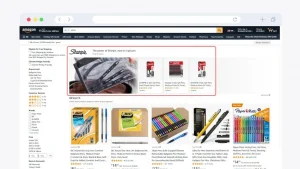
If you want to increase brand awareness and feature multiple products at once, you can use Sponsored Brand Ads. These were formerly called Amazon “Headline Search Ads” because they can be located at the top of Amazon search results. However, Amazon Sponsored Brand Ads can also be featured down a search result page further as a video featuring a product.
When these are clicked on, it leads customers either to product detail pages or to your brand’s Amazon Storefront. There are actually three different types of Sponsored Brand Ads:
- Product collection
- Store spotlight
- Video
Each of them has its own pros and cons, so test out different types of Sponsored Brands Ads to see which performs best for your brand.
Amazon Display Ads
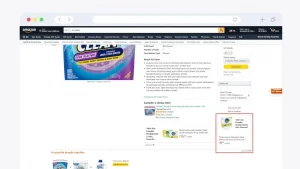
Amazon Sponsored Display Ads, sometimes called Amazon DSP advertising, are different from the ad types we’ve discussed so far because they can be placed both on Amazon and off of Amazon. This self-service Amazon DSP ads option can appear across a variety of publisher sites that have partnered with Amazon, such as Google, Netflix, and even on some apps.
Because Amazon Display Ads are one of the newest types of PPC Amazon ads, not as many sellers are using them, which could mean that your ads are less likely to be lost in the crowd if you want to use this type of ad.
One of the best features of Amazon Display Ads is the ability to retarget Amazon shoppers with your ads, both on and off Amazon, reminding them of a product they may have meant to buy to help increase conversions and sales.
Amazon Video Ads
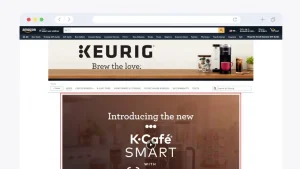
Video is a powerful way to engage shoppers, so it’s no surprise that Amazon also offers video ads. Amazon Sponsored Brand video ads were introduced a couple of years ago, so they’re still relatively new and can be a good choice if you want to try something different and stand out from the crowd since many brands are not utilizing video ads.
A few tips for Amazon Video Ads:
- Short, to the point, 15 to 30 second videos perform best
- Don’t rely on sound (it defaults to being muted), but have it there for those who turn the sound on
- Seamless loop videos perform well, causing customers to rewatch your ad
Part B: Advanced Amazon PPC Strategies
Now that you understand Amazon PPC basics, you can officially graduate to the advanced Amazon PPC strategies section! In this section, we will discuss more complex methods and tactics that can help you take your Amazon advertising campaigns to the next level. By understanding and utilizing these techniques, you can further improve your results and maximize your ROI.
Below are the Top 10 Most Powerful PPC Strategies for Amazon Sellers
1. The Optimal Campaign Structure and how to advertise products with variations
Many people get caught up in creating an unnecessarily complex Amazon campaign structure with different ad groups, keywords for each group, etc. However, in reality, simplicity is key when it comes to Amazon PPC campaign optimization.
One of the Amazon PPC best practices for campaign structure is one campaign with one ad group and one set of keywords. It sounds too simple, but it’s really the most effective Amazon PPC campaign optimization.
Why? Because running a campaign can quickly become unwieldy if you have multiple variations of the same product or when you have multiple products with different attributes, such as size and color. This Amazon PPC strategy is the best way to avoid confusion and ensure that your campaigns are focused on only one product at a time.
Our favorite of the Amazon PPC hacks to do this is to create a separate listing for all of your variations, aka a variety pack, and then create a campaign for this product if possible. While this might not make sense for products like shirts (no one wants 3 different sizes of the same shirt), this could definitely work for a product such as different flavors of tea or even different colors of the same hair accessory.
However, if you cannot create a variety pack for your product, you should still use this simplified strategy by focusing on your top-performing variety only. This way, your products are not competing with each other for ad placement, and your top-performing listing will be able to get better results.
Of course, you still want to sell your other variations as well, and by ensuring that your top-performing listing is optimized and gaining visibility, shoppers will be organically led to your other listings as well.
2. Run Product Targeting Ads targeting Competitor products that are using Google Ads for additional visibility
If your competitors are already promoting their products through Google ads, why not utilize Amazon Product Targeting ads to feature your products on those listings that are getting tons of visibility? You can target competitor listings that are already optimized and getting traffic from Google. This is one of the best Amazon PPC hacks out there and is great for brands that have products that are similar or compatible with competitors.
This is an opportunity for you to capitalize on their success and can be a very effective Amazon PPC strategy as it will help you piggyback off their google search audience, who may be interested in your product.
3. Ranking Strategy using PPC & Manychat for your top 3-10 keywords
If you want to get to the top of search on Amazon for a new product, ranking organically can take a long time. But we want to share a way to use PPC and Manychat to create a top of search campaign in Amazon to start ranking for your top keywords.
Simply follow the steps below:
- Do your Amazon PPC keyword research and select 2-3 highly relevant keywords you want to rank on page 1 for. Really focus on highly relevant keywords, and if you’re having trouble with this, you can find your top competitors and do a Reverse ASIN analysis on the group.
- Carefully optimize your listing for the 2-3 highly relevant keywords you picked out in step one. Make sure they’re in your title, Backend Subject Matter Fields, Bullets, and Description.
- Build a Manychat Messenger Bot Sequence directing people to “Search-Find-Buy” at full price with a full refund after they’ve purchased. Essentially, interested parties will be provided with instructions on how to organically search for your item and purchase it at full price with the incentive of getting a refund afterward.
- Create a Facebook Ad to advertise your “Search Find Buy” promotion. With an attention-grabbing image and a simple call to action specifying that the product has a 100% rebate, you’ll be able to drive traffic to your Manychat sequence.
- Set up an aggressive Amazon ads keyword targeting campaign for the keywords you want to rank for. This campaign should be much higher than the Amazon PPC suggested bid because this is the only way you Search Find Buy customers will be able to find the product.
- Turn off review follow-up sequences for 45 days after completion of marketing. Why? Because you want to stay compliant with Amazon’s TOS, and you don’t want any reviews from these customers triggering the “incentivized reviews” clause and causing issues for your account.
- Repeat for additional keywords. Once you do this for one keyword, you can do it over and over for additional keywords to outrank competitors and stay at the top of the search results pages for relevant keywords.
4. Setting up low cost top of funnel ads using “Catch All Campaigns”
Have you tried setting up catch all campaigns? This is one of the best Amazon PPC hacks for taking advantage of random times when there is less competition and lower bids.
To set up a catch all campaign, all you need to do is create an exact campaign with all keywords at low bids. Think .10 to .25 at most, with “Dynamic Up and Down” selected as the bidding strategy. This will allow Amazon to automatically adjust your bids based on the competition, and you may just catch some bids that slip through the cracks. You can take this one step further by adding “Placement Modifiers” of 100% to 900% depending on specific placements you want to target based on their conversion rates.
Remember to then monitor your results and use this campaign to target any keywords that are getting impressions but no clicks. This is a great way to optimize your campaigns for maximum exposure, even at a low cost.
5. Group Similar products together
When it comes to Amazon PPC best practices, grouping similar products together is one of the best Amazon campaign structures for sellers with groups of similar products. By creating an Amazon PPC strategy where you group like items together, you can easily organize your campaigns almost by category within your account.
One of the best ways to do this is by creating a new campaign based on the product category and then dividing them into smaller subcategories based on the product. For example, if you sell puzzles, you can create a “puzzle” campaign with “dog puzzles” and “cat puzzles” as separate ad groups.
Of course, this Amazon PPC strategy works best if you sell multiple products within a certain category, so make sure that you use this Amazon PPC hack correctly and don’t try to group products that are not similar in the name of attempting to simplify your campaign structure.
6. Brand Defensive & Offensive Ads
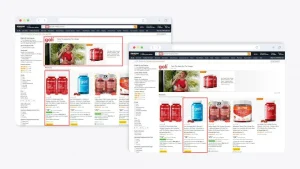
Have you heard of offensive and defensive ads? If you haven’t been doing PPC advertising for long, you may not know that one effective Amazon PPC strategy is to use brand defensive and offensive ads.
Amazon brand offensive ads target your competitors branded keywords so that your products appear when a customer searches for that competitor’s products. While this might seem counterintuitive at first, keep in mind that you are still targeting keywords relevant to your niche or product category, so you’re simply introducing your competitor’s buyers to your own similar products.
These customers already know what they want because they’re searching for a specific brand, so your ads need to be targeted and relevant. Keep in mind, though, that though you may be able to pull some customers your way, customers using branded search terms are more likely to purchase the brand they searched for, so it’s important to consider if there is a profitable ROI there.
Now let’s talk about Amazon brand defensive ads. If you’re targeting branded competitor keywords, it’s important to also be prepared for when your competitors start targeting your brand name too.
When you set up a brand defensive ad, you’re basically setting up an Amazon PPC campaign specifically geared towards targeting your own branded keywords with the goal of preventing customers from clicking on your competitor’s ads instead of yours.
Many sellers overlook this type of ad because it’s easy to assume that if a potential buyer is searching for your brand, they’re already interested in buying from you. However, it’s important to think about it from the customer’s perspective and remember that customers might simply prefer to click on a lower price or be swayed by a flashy ad instead of sticking with their initial intention to purchase from your brand.
While both of these types of ads are important to have in your Amazon PPC strategy, it may be best to focus on brand-defensive ads first to ensure that you’re protecting your brand and reputation from potential competitors. Then move on to offensive ads once you have achieved a solid ranking for your own products.
7. Running A/B testing on Sponsored Brand or Headline Search Ads
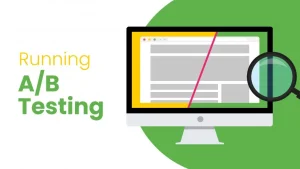
Amazon PPC advertising is constantly changing, and one of the best ways to keep up with all of these changes is by constantly conducting A/B testing on your ads. This is especially true for Amazon Sponsored Brand ads (previously called Amazon Headline Search ads).
With Amazon Sponsored Brand Ads, your listings aren’t simply showing up with other search results, they are being featured in more of an advertisement style placement on Amazon either at the top or within the search results. Running A/B tests on what products you’re grouping together and how you’re configuring your ads, as well as what search terms you’re targeting, can help you optimize your Sponsored Brand ads in a way that maximizes conversions.
Also, remember that although you may be tempted to stick with what is working for the time being, Amazon is always updating and changing the algorithm of its ad system, so it’s important to keep up with these changes and adjust your strategy accordingly.
8. Sponsored Display Ad Strategies
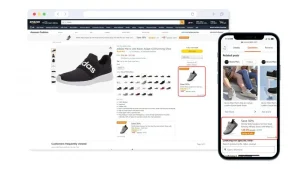
If you’re looking to maximize your Amazon PPC advertising efforts, one strategy you may want to consider is using Sponsored Display Ads. There are plenty of different strategies you can employ with Sponsored Display Ads, so it’s important to experiment and figure out which strategy works best for your business and your listings.
Here are some quick ideas to get you started with Amazon Sponsored Display ads:
- Use Amazon product display ads to appear on the product page of a competing or complementary product
- Target your own products to cross-sell complimentary products
- Upsell a more expensive product from your brand by targeting one of your cheaper listings
- Increase order value by targeting a listing with a single product and using Amazon DSP ads to show potential customers a larger quantity
- Retarget your audience or even your competitor’s audience to those who haven’t purchased yet
- Use Amazon display ads to promote a deal or coupon directly on the ad to improve CTR
- Retarget purchasers on high repeat items like consumables
Amazon DSP advertising has so much potential if you get creative with it and use it to your advantage. Whatever you do, always make sure that you are tracking and measuring the performance of your ads so that you can optimize based on what’s working and what isn’t. With a little bit of trial and error, you’ll soon be creating effective Amazon Sponsored Display ad strategies that help grow your business on Amazon.
9. Try Brand and Display Video Targeting Ads

Truth be told, people are shying away from reading text and relying on video more than ever. So if you’ve been ignoring the increasing importance of Amazon video ads, now is the time to start experimenting with them.
With brand and display video ads on Amazon, you can show your video directly in a customer’s search results when they’re most engaged. This makes it easier for customers to learn about your brand and make purchasing decisions on their own terms.
Amazon Sponsored Brand video ads, if nothing else, are a good way to get potential customers to stop scrolling and pay attention to your brand for a few seconds. And if you can captivate their attention and get them interested in your product(s), it’s more likely that they will eventually convert.
The same can be said about Amazon display video ads, which can be shown in many different placements on Amazon, from the home page to detail pages, including those on tablets or smartphones.
To get the most out of Amazon video advertising, make sure you are thinking strategically and testing different variations of your ads to see what resonates with your target audience.
10. Use Bid Adjustments via placements to scale faster
In Amazon PPC advertising, your ads are going to show up on one of several pages, like the top of search on Amazon, within the search results, or even on product detail or checkout pages. Luckily, Amazon provides a placement report to see which of these placements are driving traffic and important conversions for you.
Armed with this information, you can adjust bids by placement on Amazon to scale your ads based on the placement that’s working best for your products. For example, if your search result placements are converting well, increasing your bids on those can help expand your reach and drive more traffic back to your listings.
With a little bit of experimentation and optimization, you’ll be able to scale your ad spend across all placements and increase your ROI on Amazon PPC ads.
Advanced Analytics Techniques

Advanced analytics techniques can significantly enhance your Amazon PPC campaign’s effectiveness by providing deeper insights into your data. These methods help optimize advertising strategies and achieve better ROI.
- Predictive Analytics: Utilize historical data to forecast future trends in consumer behavior and ad performance, allowing for proactive campaign adjustments.
- Segmentation Analysis: Divide your customer base into distinct groups based on their purchasing behavior, demographics, or engagement levels for highly targeted ads.
- Granular A/B Testing: Test different elements of your ads, such as images, call-to-action texts, and pricing strategies, to determine what resonates best with your audience.
Incorporating these advanced analytics techniques into your Amazon PPC campaigns allows for smarter decisions, tailored strategies, and ultimately, more successful outcomes.
Final Thoughts
Getting started with Amazon PPC advertising can seem confusing, especially if you have little to no experience with PPC advertising. But it’s the best way to level up your Amazon business, drive more traffic to your listings, and ultimately increase your sales.
To get the most out of Amazon PPC ads, understand the basics, choose a goal to focus on, and remember to always test and measure the performance of your ads so you can optimize based on what’s working best for your business. A well-planned amazon ppc campaign strategy is essential for navigating the complexities of Amazon advertising and achieving lasting success.
Although we’ve covered a lot of information and different strategies in this guide, remember that even the most experienced marketers are always learning so it’s ok to start slow and build your knowledge as you gain experience from constantly testing and analyzing results.
With these best Amazon PPC strategies for 2024, you’re equipped to significantly boost your Amazon business.
Let me know if FosterFBA can help you scale your Amazon PPC Strategy. Get your free audit and identify opportunities to grow today.
P.S: If you are making over $25K/month and want to take your PPC sales to the next level. We’re offering “done-for-you” Amazon PPC management & consulting services that does just that. You can schedule a free strategy session and audit of your ads to see if we’re a good fit:
>>Click here to schedule your free 15 minute strategy session with me

